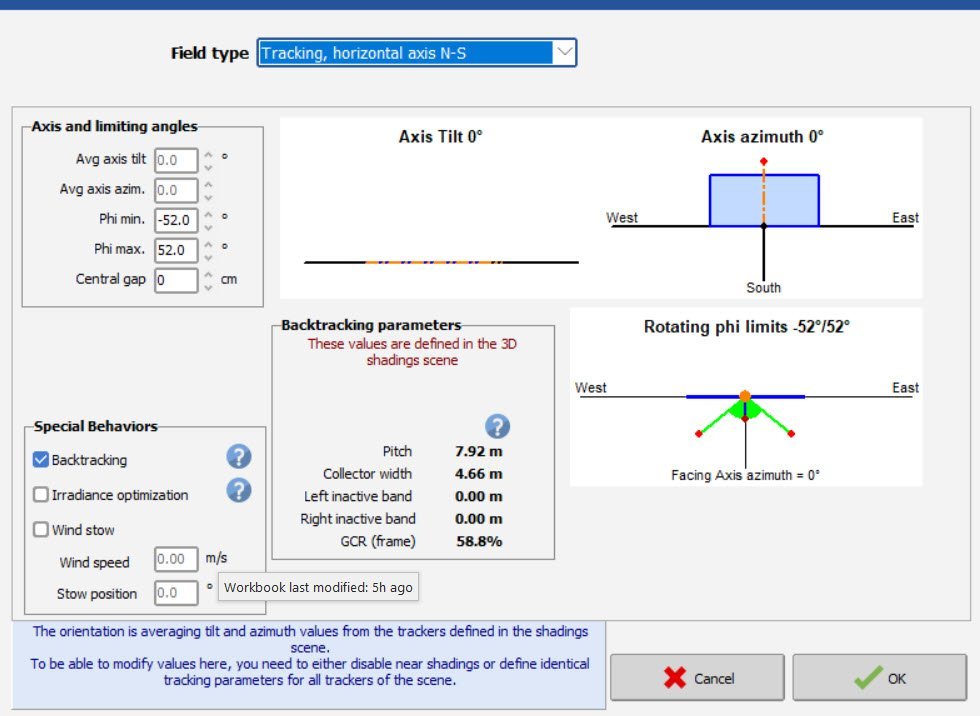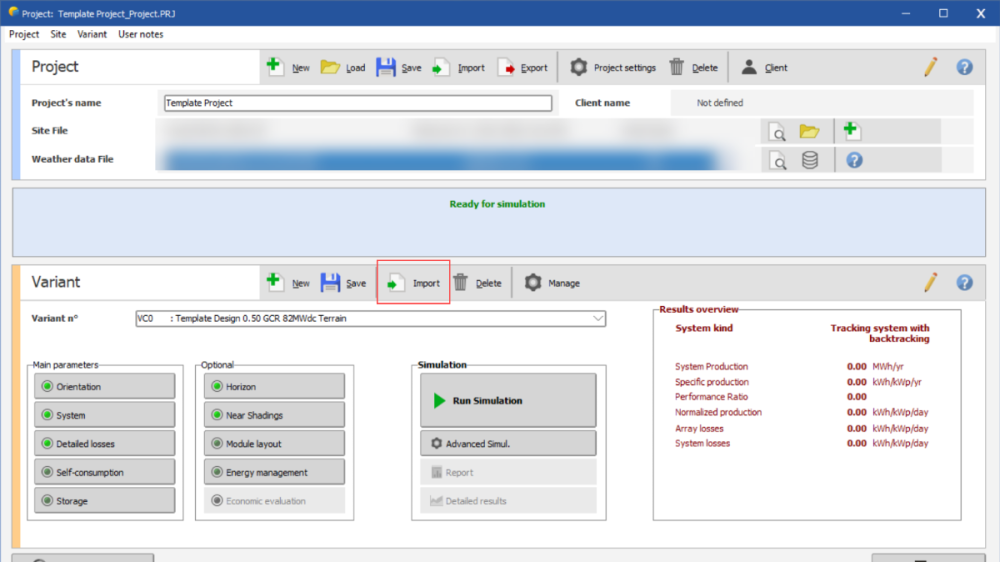-
Posts
885 -
Joined
-
Last visited
Everything posted by dtarin
-
Getting an error even though the thresholds have been adjusted in system settings. 7.4.7. Bifacial system.
-
The PVsyst wind stow estimation feature is not available for Unlimited trackers N-S. Can this be added?
-
- 1 reply
-
- pv losses
- losses due to temperature
-
(and 1 more)
Tagged with:
-
Create multiple variants with the different bifacial settings you wish to test (height from ground, albedo), check the box below. Spacing and tilt are a little different, those inputs for bifacial inputs are derived from other places (i.e., shade scene, orientation menu).
-
GlobInc. You might have reflections at low sun angles with that installation. For a fixed tilt system, these can be installed on a weather station free from shading and reflection.
-
-

AC losses: the grid voltage has an unrealistic value
dtarin replied to Aaron3707's topic in Simulations
My guess is that the warning is with respect to the HV portion, which you dont have shown in the image. The OND file doesnt account for LV losses. LV losses are zero since the MV transformer is connected to the inverter. You will define a MV line loss however from the MV inverter(s) to the HV transformer(s). Since the OND file accounts for the MV transformer, maintain 0% in the no-load and full-load loss. -
There is not unless you model each inverter separately in different variants.
-
You can model it in certain software. Here is one paper to reference. https://www.sciencedirect.com/science/article/pii/S2667113121000048
-
@Robin Vincent Is there a reason for a limit of 5 periods?
-

Template which contains all the info for same type of projetcs.
dtarin replied to ShivamPandey's topic in Suggestions
You can for example create a project called "Template Project" (Template Project.PRJ)which stores your template project variants (i.e., Template Project.VC0, etc.). Then when you want to use this template design in some other project, import the template variant "Template Project.VC0". -
In my experience, Ga-doped modules are still susceptible to LID, and I have also seen LID loss in TOPCon tests. The LID loss for these types are less than p-type boron-doped modules, but I have not seen zero LID in Ga-doped or N-type TOPCon modules. I am not familiar with HJT type modules.
-
Increase the averaging interval to reduce the number of orientations in the shade scene. If there are multiple orientations after you've settled on the number, they will need a corresponding subarray under system menu.
-
Not intended to circumvent the request, but in the interim, you can post-process the limit in excel or other tool with the 8760, or modify the OND file (may result in slightly lower production).
-
Hello, It would be very useful to see two features related to the shading factor table: Increased resolution in the shading factor table Allow user to define additional points in the table, or provide additional preset tables with additional values. The purpose of the shading factor table is to reduce simulation time, but it adds additional shading loss. This is fine in principle, but it would be helpful if users could investigate and find that balance between reduced simulation time and reducing the overestimation of shading losses. Additional points in the lower elevations would valuable. Allow users to manually enter or import shading factor tables, linear and mod. strings Allow shading factor tables to be a variable for batch processing. This could be a file reference in a PVsyst-defined format. User-defined/imported shading factor tables could be used in other projects for site characterization and evaluating different scenarios in development. Plants are getting larger, and when modeling trackers with terrain, the simulations times can be quite large, but when using fast mode, the overestimation is not always acceptable depending on the purpose of the simulation.
-
You might have undersized your inverters or have too high of losses prior to the injection point. Posting your waterfall results will help identify.
-
Running unlimited sheds with a fixed tilt angle, where phi_min = phi_max, does not fix the tilt angle of the tracker, and it continues to backtrack. This was possible in 7.4.2, but has not been since that version. It does not matter whether backtracking is checked or not, or whether it is done through batch mode or regular simulation.
-
Yes, under advanced simulation > output file, you can select the variables on the right you want, then save that as a template. You can have multiple templates.
-
For terrain following trackers we model all trackers 1 string in length to adapt as much as possible while retaining the electrical shading effect one would expect. Using the module layout shading calculation you can assign strings to cross multiple tables, and the limit in PVsyst can be bypassed in the settings (I think before it was 5MW, not sure if that is still a thing). One other possibility is if you were originally modeling half cell modules with 2 in width by 1 in height (for single string racks), you could model half racks 1x1. Running a test between this method and a module layout simulation might inform you on how accurate it is.
-
It is not common for folks to share OND files here. Your best bet is to reach out to the manufacturer.
-
One point to clarify, if the meteo data is taken directly from the pyranometer, then it is to be excluded. If the pyranometer data was used to adjust satellite data, then it is possibly excluded from the resulting adapted data (you will need to verify this), and thus you would include the horizon profile.
-
Export the simulation to excel and you will have hourly data. Include the elec. loss according to shadings in the output.
-

Does PVsyst factor in the movement of the windturbine blades
dtarin replied to Niels's topic in Shadings and tracking
Yes, the turbines in PVsyst will cast shadow, no, they do not rotate.






